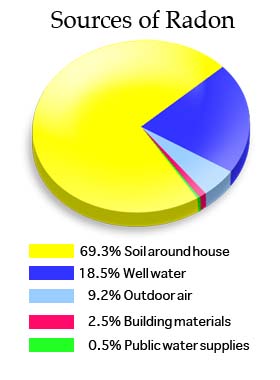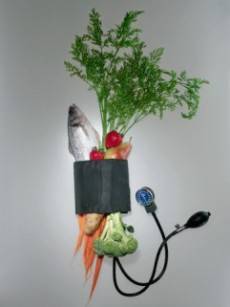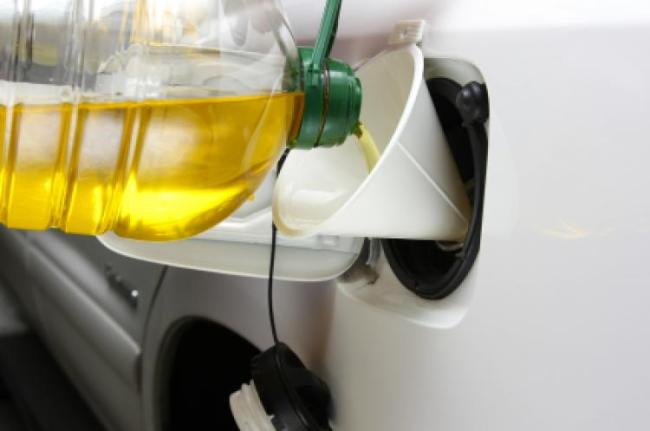Eliminate Radon Dangers in Your Home
Since you cannot see, smell or taste radon gas, it is not detectable in your home. So, why worry about radon? The National Cancer Institute reports that radon is the second-leading cause of lung cancer in the United States next to smoking.
The prevalence of radon is not isolated to one geographic area or type of home. In fact, one in every 15 homes has an elevated radon level, so it’s important for you to test and eliminate radon dangers at your residence.
What is Radon Gas?
Radon is a naturally-occurring radioactive gas produced by the breakdown of uranium in soil, rocks and water. Since the air pressure in a typical home is lower than the pressure in the soil around the foundation, the home acts like a vacuum and draws radon in through cracks in the foundation.
Radon may also be present in the water source and can be released into the air when water is used for general household purposes such as showering, or ingested when drinking. Testing for radon is the only way to determine if your indoor air quality and/or water are affected.
Testing for Radon
According to the EPA, radon gas levels can vary by day, season and geographic area. The radon levels can even be different in your home as compared to your next door neighbor’s home. Therefore, all potential homebuyers, current homeowners and home sellers should have their homes tested for radon.
The EPA recommends testing for radon under the following circumstances:
- The home was never tested.
- The home was tested more than two years prior.
- The home was renovated since it was last tested.
- You plan to occupy a lower level of the home than what was originally tested, such as the basement.
To test a home for radon, you can order a kit by mail from a qualified radon measurement service provider, purchase a radon kit from a local hardware store or hire a qualified radon tester (often also a home inspector).
If a radon test reveals that your home’s level is dangerous, you can install a radon mitigation system. A qualified radon reduction contractor can install a system in typically less than a day. If your home’s water source has high levels of radon, too, a point-of-entry treatment device can be installed to reduce emissions.
Ensure that your family is breathing easy by testing for radon and installing a radon mitigation system if the gas levels in your home are too high.
For more information on radon testing and your home insurance , contact your agent.
High Blood Pressure
Each time the heart beats, it pumps out blood into the arteries. Blood pressure is highest when the heart beats (called systolic pressure) and lowest when at rest (diastolic pressure). This is why blood pressure is always given as two numbers, such as 120/80, which is considered the normal range. Once the level reaches 140/90 or above, it is considered high blood pressure. With this condition, the heart and arteries work harder, and the chances of a stroke, heart attack or kidney problems are greater.
Causes and Risk Factors
No single specific cause has been identified in people with high blood pressure, but research is ongoing. In some people, it is the result of another medical problem or medication. When the cause is known, this is called secondary high blood pressure. Research has shown that the following factors put one more at risk for high blood pressure:
- Obesity
- Being African-American
- If male, being over age 45; if female, being over age 55
- A family history
- Having prehypertension (blood pressure in the 120-139/80-89 range)
- Excessive salt and/or alcohol consumption
- Not enough potassium in the diet
- Being physically inactive
- Having ongoing stress
- Smoking
- If female, taking certain oral contraceptives
Symptoms
Those with high blood pressure may have it for years without knowing, due to its lack of symptoms. The only way to find out is to have routine blood pressure checks during every visit to the doctor.
The Importance of Treatment
The first and best course of action when high blood pressure is discovered is to change eating and exercise habits. However, sometimes even when a person makes healthy changes, blood pressure remains high. In that case, a physician will most likely prescribe a blood pressure medication. If left untreated, high blood pressure can cause:
- Enlarging of the heart, which leads to heart failure
- Aneurysms in the arteries of the heart, brain, legs, intestines or spleen
- Narrowing of the blood vessels in the kidney, leading to kidney failure
- Hardening of the arteries, which can cause a heart attack, stroke or kidney failure
- Blood vessels bursting in the eyes
Prevention
High blood pressure can easily be prevented. Some of the best ways to avoid the condition include:
- Limiting salt, fats and alcohol
- Eating healthy foods such as fruits, vegetables, whole grains and low-fat dairy products
- Maintaining a healthy weight
- Being physically active
- Quitting smoking
Did You Know..?
Those with high blood pressure often exhibit few or no symptoms, which is why the condition is frequently referred to as the “silent killer.” For more information on controlling blood pressure, contact your physician. For more information regarding life insurance, contact your agent.
Going Green When You Drive
Climbing gas prices and an increased focus on the effect fossil fuels have on the environment have drivers looking for ways to not only to keep costs down but also to protect the planet.
Drive Green
Vehicles that run on gasoline release greenhouse gases into the atmosphere. These gases contribute to climate change, air pollution and disease. To get better gas mileage and release cleaner emissions, drive a hybrid vehicle – these cars run on electricity, not just gas. Whether you get a hybrid or not, select a car that gets the best miles per gallon (MPG).
- Use vegetable-based biodiesel fuel in diesel cars and trucks.
- Use ethanol gas if your vehicle can use it.
- Buy an electric car or plug-in hybrid vehicle.
Change Your Driving Habits
The way you drive can affect your fuel economy.
- Avoid sudden starts and stops and drive the speed limit.
- Keep your engine speeds between 1,200 to 3,000 RPMs and up-shift between 2,000 to 2,500 RPMs.
- Do errands in one trip.
- Get directions to avoid getting lost.
- Turn off your car if you will be idling for more than a minute.
Keep Up On Maintenance
Make sure you get regular tune-ups on your vehicle, including oil changes and cleaning your air filter. Don’t forget these other maintenance suggestions:
- Check your tire pressure. Underinflated tires means the engine has to work harder, resulting in burning more fuel.
- Remove excess items in your vehicle – extra weight can have an effect on your fuel economy.
- Avoid using the air conditioner. Instead, open your windows, use an electric or solar fan, park in the shade or use a reflective windshield shade to keep your car cool.
Find Alternatives to Driving
- Carpool with coworkers and friends.
- Try a car-sharing program, such as FlexCar or ZipCar.
- Use public transportation, walk, rollerblade or bike to places you need to be.
- If possible, try altering your commute. Avoiding peak traffic times
can mean less gas is spent in stop and start traffic.
Did You Know?
Vehicles that get better gas mileage can save you hundreds of dollars every year. To find out how efficient your vehicle is compared to others, check out www.fueleconomy.gov.
For more information on going green when you drive, contact your auto insurance agent.
Eat Well, Live Well
Replacing unhealthy eating habits with healthier ones can be difficult, especially if unhealthy habits are all you’ve ever known. One key to making lasting improvements in your diet is to make changes in stages. Start with a small, simple change and stick to it for a week. After one change has been mastered, add another.
Some Ideas to Get You Started
- Eat breakfast.
- Replace one sugary drink per day with a glass of water.
- Eat one to two more fruits or vegetables each day.
- Plan a healthy snack for each day of the week.
- Switch to a low-fat version of one of your favorite foods.
- Plan three meals and two snacks every day.
- Plan as many home-cooked meals as you can, as they usually have fewer calories, more reasonable portions and cost less than typical meals eaten at restaurants.
Set an Example
Parents play a big role in guiding their children’s eating habits with the examples they set, the foods they make available in the home and the mealtime experiences that they create for their families.
Offer healthy snacks such as fruit, low-fat cottage cheese or yogurt, frozen juice bars, applesauce, celery, apples with peanut butter, raw vegetables, graham crackers, fig bars or whole wheat crackers with low-fat cheese. Large portions contain too many calories. A good-sized snack for a typical adult may be a single-serving container of yogurt, but for a preschooler, two or three tablespoons of yogurt is enough.
Make Eating an Enjoyable Activity for the Whole Family
Family meals can be a time to monitor what children are eating and to reconnect with each other. Involve children in food preparation and clean-up, and sit down with them when they eat. The idea is to build healthy lifelong eating habits.
Some healthy eating tips include the following:
- Eat plenty of fruit and vegetables—half your plate at each meal should be vegetables or fruit.
- Beware of sweetened drinks—sodas and sports drinks are high in calories. Keep in mind that the calories in juice can also quickly add up.
- Choose food sensibly when eating out. Restaurants are often required to make nutrition information readily available—if you don’t see brochures sitting out, or nutrition information listed on the menu, ask.
Healthy Food Tips When Eating Out
- Ask if you don’t know what is in a dish or the serving size.
- Eat the same portion size you would at home.
- Ask for sauces, gravy and dressings on the side—or avoid them altogether.
- Order foods that are not breaded or fried.
- Order fruit for dessert.
- Ask for substitutions, such as a vegetable instead of fries.
- Ask for low-calorie versions of food. Vinegar and oil or a squeeze of lemon are both better than high-fat dressings or sauces.
Did You Know…?
Substituting chips and candy bars with snack-sized portions of veggies will cut down on the calories and cholesterol in your diet. Not only are most vegetables low in calories and fat, but they are all cholesterol-free.
For more information on diets to keep you living healthy, contact your physician. For more information regarding life insurance, contact your agent.
Save Money and Energy in Your Household
According to the U.S. Department of Energy, the typical American family spends over $1,600 a year on home utility bills, and a large portion of that energy is wasted. Not to fear: there are several things you can do each month to conserve energy and reduce the strain on your wallet.
Conduct a Home Energy Audit
An energy audit will show you which areas of your home use the most energy. You can conduct this yourself, contact your local utility or call an independent energy auditor. A comprehensive evaluation should include:
- Checking insulation levels
- Looking for open fireplace dampers
- Searching for holes or cracks around doors, light and plumbing fixtures, and other places where air may leak out
- Ensuring appliances and heating and cooling systems are properly maintained.
Temperature Tips
- Weatherize your home – caulk and weather-strip any doors and windows that leak air.

- Install a programmable thermostat that will reduce heating (or turn air conditioning up) at night and when you are not home.
- Consider replacing single-pane windows with double-pane; they have coatings that reduce heat loss or gain, depending on the season.
- Keep your thermostat under 70 degrees in the winter and a few degrees cooler than the outside temperature in the summer.
Water Use
- Repair leaky faucets immediately.
- Use low-flow shower heads.
- Insulate your hot-water storage tank and pipes.
- Drain a quart of water from your tank every three months to remove sediment (which impedes heat transfer and lowers efficiency).
- Lower the hot water heater to 120 degrees.
- Take short showers instead of baths.
- Wash only full loads of dishes and/or laundry.
- Air-dry dishes and line-dry clothes if possible.
Renewable Energy
There are more options than ever to use renewable energy. When building a new home, orient it to avoid overhead summer sun and to benefit from winter sun in cooler climates. Try a solar pool heating system, which can cut costs for heating swimming pools or hot tubs. Under certain conditions, installing solar cells might be right for you.
Vehicle Use
Improve gas mileage by:
- Avoiding aggressive driving
- Observing the speed limit
- Removing roof racks or carriers if not used often
- Keeping up with maintenance – clean air filters can improve gas mileage by as much as 10 percent.
- Ensuring tires are properly inflated and aligned
- Using the correct grade of oil
Energy Star® Products
Whenever you are purchasing new equipment or appliances, look for the Energy Star logo. These products meet strict energy efficiency guidelines set by the EPA and U.S. Department of Energy. For more information, go to www.energystar.gov.
Did you know…?
The key to achieving savings in your home is a whole-house energy efficiency plan; this ensures that the dollars you invest are spent wisely. Energy-efficient improvements not only make your home more comfortable, but can yield long-term financial rewards, such as bringing in a higher price when you sell it.
Contact your home insurance agent for more questions on energy savings and heating your home.
Cold-Weather Energy Savings
Energy bills can skyrocket in the colder months. From using more heat to keeping more lights on when it gets dark early, limiting energy consumption becomes even more important in the winter. Follow these tips for conserving energy in cooler weather:
- Set your thermostat lower when you’re not home, or even while you are asleep. Even lowering the heat from 70 to 65 degrees Fahrenheit can make your bills shrink.
- Use a portable, electric space heater. Space heaters are energy-efficient and are especially useful when most of your time is spent in one or two rooms—you won’t be bothered by a lower thermostat temperature if the space you’re in is nice and cozy. Make sure to research fire safety when using a space heater.
- Make sure doors and windows seal tightly. If they don’t, fix them to avoid cold air seeping in and warm air escaping.
- Insulate your pipes, even the cold water ones. In addition to preventing your pipes from bursting, insulating them with half-inch thick foam can save you about $25 annually.
- Lower your water heater to 120 degrees Fahrenheit. If your water is being heated to a lower temperature, the bill will decrease. Also, consider swapping your electric water heater with a less-expensive natural gas one.
Be aware of your energy usage as winter approaches—lowering it can save you quite a bit of money. If you have any questions on keeping costs low, even on your home insurance, contact your agent.
Quit for Your Loved Ones: Secondhand smoke is hazardous for their health
You likely know that smoking is dangerous for your health, and can cause many diseases and serious health conditions, but did you know that you are putting your loved ones at risk as well?
Secondhand Smoke
Secondhand smoke has two forms: the smoke that is exhaled by a smoker and the smoke from a burning cigarette, cigar or pipe. Anyone breathing in any type of smoke is taking in the same dangerous chemicals and toxins as the person who is smoking.
Do you smoke in your home, in your car or at work? If so, you are endangering your friends, co-workers, pets and family members.
Health Risks
Secondhand smoke can cause a variety of health conditions and diseases, including:
- Heart disease
- Lung cancer
- Asthma
- Middle ear infections in children
- Chest discomfort, coughing and trouble breathing
- Pneumonia and bronchitis, especially in children
- Sudden infant death syndrome (SIDS)
Surgeon General Report
In 2006, the U.S. Surgeon General conducted a report on the effects of secondhand smoke. Here are some of the key findings:
- Secondhand smoke causes premature death and disease in children and adults who do not smoke.
- Children exposed to secondhand smoke are at an increased risk for many respiratory conditions and ear problems.
- There is no safe exposure level to secondhand smoke.
- Secondhand smoke immediately affects heart and blood circulation in a harmful way.
- Despite the increasing limitations on smoking in public places, millions of Americans are still exposed to secondhand smoke in their homes and workplaces.
- The only way to prevent secondhand smoke exposure is to prohibit all smoking in that building. Walls and ventilation systems do not prevent secondhand smoke exposure for nonsmokers.
Did you know…?
The American Cancer Society estimates that each year, 46,000 nonsmokers who live with smokers die from heart disease related to secondhand smoke. In addition, about 3,400 nonsmoking adults die each year from lung cancer caused by secondhand smoke.
Why Quit?
If you’re looking for motivation to quit for good, do it for your loved ones. You can improve and protect their health along with your own.
For more information on quitting smoking, contact your physician. Any questions on your insurance, contact your agent.
Money-Saving Freezer Meals
With work and school, errands and extra-curricular activities, it can be nearly impossible to find the time to cook and eat a weekday meal this time of year. With a little planning, you can take the pressure off yourself by making and freezing meals in advance.
Because you can control what you put into each meal, homemade meals can be more nutritious and less expensive than store-bought frozen meals. Read on for tips on how to get the most out of your homemade freezer meals.
The meals to freeze
Soups, stews and chili, popular dishes at this time of the year, will freeze and reheat excellently, but anything with a lot of moisture in it will freeze well.
How to freeze them
Freeze food as rapidly as possible to maintain its quality. Rapid freezing prevents undesirable large ice crystals from forming because the molecules don’t have time to form into the characteristic six-sided snowflake.
To freeze, place the dish into meal-sized containers or packages, and label and date the packages. If using a plastic or glass container, leave a little room at the top so the food may expand. If using a plastic freezer bag, try to leave as little air in the bag as possible. Store in a freezer kept at zero degrees F or below.
How long to keep them
According to the USDA, cooked meat, soups, stews and casseroles may be stored for 2-3 months; cooked poultry for up to 4 months; and frozen dinners and entrees may be kept frozen for 3 to 4 months.
For more information and a full timetable visit www.fsis.usda.gov/FactSheets/Focus_On_Freezing/index.asp.
For more information on saving money on your insurance, contact your agent.
Live Green in Every Room in Your Home
Living green, building green and surrounding yourself with earth-friendly products minimizes the negative impact you have on the natural world. At the same time, you are creating a healthy environment for yourself and your family. By abiding by green principles, not only are you keeping your family from getting sick, you are also looking out for Mother Nature’s limited resources. Creating a healthy environment in your home shows a positive reflection to your Michigan insurance. Here are some recommendations for living green in every room of your home:
Earth-Friendly Tips for Your Home
- Remove old carpeting and heavy curtains that are caked in years of dust.
- Professionally clean ductwork and forced-air heaters regularly to remove grime, dirt and soot.
- Install natural linoleum, cork, ceramic tile or recycled rubber instead of vinyl flooring. Vinyl gives off toxic chemicals.
- Install cabinets that are made of coat pressed woods with a low-VOC sealant instead of particleboard or plywood cabinets. These materials can give off formaldehyde, which is bad for your health.
- Choose low-VOC natural latex paints for interior walls.
- Install a solar-powered water heater.
- Increase insulation in your attic, walls and flooring.
- Use compact fluorescent light bulbs (CFLs) throughout your house to significantly reduce your electricity bill and the amount of energy used.
- Keep your heat low. For every degree that you turn your thermostat below 70, you can save 320 pounds of greenhouse gases (natural gas heat) or 236 pounds of electric heat.
- Install Energy Star appliances certified by the Environmental Protection Agency.
- Purchase a composting toilet, which breaks down human waste into nutrient-rich substances that can be used to fertilize trees and inedible plants.
- Use recycled, chlorine-free toilet paper, facial tissues and petrochemical-free cosmetics.
- Use baking soda, vinegar and tea tree oil to disinfect your bathroom as opposed to traditional cleaning products made with harsh chemicals.
- Turn off the water while brushing your teeth and shampooing and only turn it back on to rinse.
- Line dry your clothes instead of drying them in the dryer.
Not all, but some of these conditions are crucial to your Michigan home insurance. It is best to live as energy-efficient and safe as possible for the sake of your home and your family.
Growing native plants in your garden is much friendlier on the environment since they have evolved to survive in the climate in which you live. These plants do not need much help to grow and require less than half the amount of water to survive as compared to non-native plants.
Contact your Michigan insurance agent for more ways to live “green.”










